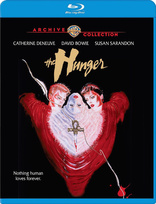The Hunger Blu-ray Movie
HomeThe Hunger Blu-ray Movie 
Warner Archive CollectionWarner Bros. | 1983 | 97 min | Rated R | Aug 18, 2015
Movie rating
7 | / 10 |
Blu-ray rating
| Users | 4.5 | |
| Reviewer | 4.0 | |
| Overall | 4.0 |
Overview
The Hunger (1983)
Miriam Blaylock collects Renaissance art, ancient Egyptian pendants, lovers and souls. Alive and fashionably chic in Manhattan, Miriam shares an eternal blood lust with fellow fiend and refined husband John. But when John abruptly begins to age and seeks out researcher Dr. Sarah Roberts for help, Miriam soon eyes the woman as a replacement for John.
Starring: Catherine Deneuve, David Bowie, Susan Sarandon, Cliff De Young, Beth EhlersDirector: Tony Scott
| Horror | Uncertain |
| Erotic | Uncertain |
| Thriller | Uncertain |
| Romance | Uncertain |
Specifications
Video
Video codec: MPEG-4 AVC
Video resolution: 1080p
Aspect ratio: 2.39:1
Original aspect ratio: 2.39:1
Audio
English: DTS-HD Master Audio 2.0 Mono (48kHz, 24-bit)
Subtitles
English SDH
Discs
50GB Blu-ray Disc
Single disc (1 BD)
Playback
Region free
Review
Rating summary
| Movie | 4.0 | |
| Video | 4.5 | |
| Audio | 4.5 | |
| Extras | 2.5 | |
| Overall | 4.0 |
The Hunger Blu-ray Movie Review
"I Want Some More!"
Reviewed by Michael Reuben August 16, 2015Tony Scott's first film, The Hunger, suffered much the same fate as his brother Ridley's first feature, The Duellists, six years earlier. A few people liked it, most dismissed it as precious and artsy, and the studio, as Scott later put it, "painted out my parking spot". Further opportunities dried up for a time, including the first adaptation of Man on Fire, which Scott was preparing to direct. (It was ultimately made by French director Élie Chouraqui, but Scott got a chance to remake it seventeen years later with Denzel Washington.) Much like his older brother, though, Scott bounced back with his second film, Top Gun, which became an international hit and remains iconic to this day. With an output that had highs and lows, but a style that was always distinctive, the younger Scott remained a vital force in film until his death in 2012. The Hunger has retained a cult fan base for a number of reasons, one of which is its visual splendor. Scott's first love was painting, in which he received formal training for eight years. He was "dragged" into filmmaking by his brother, as he recalls in his commentary to The Hunger, and he learned the craft directing commercials, where it is the director's job to fuss over the tiniest detail in the frame. Along with such filmmakers as Adrian Lyne, Alan Parker, Hugh Hudson and his brother Ridley, Scott brought the same aesthetic to mainstream features. Although Scott was certainly not the first director to compose his frames like art photography (Stanley Kubrick had been doing so for years), Scott's style in The Hunger so blurred the lines between narrative art and manipulative advertising that critics were appalled (especially those nostalgic for the gritty realism of the now-departed Seventies). But Scott's approach was exactly the right one for The Hunger. Adapted from Whitley Strieber's novel of the same name, the film anticipated the contemporary fascination with vampires—although the word itself is never used—as alluring figures of mystery and romance, even potential heroes, if only they can control that pesky habit of killing people to drink their blood. True Blood, Angel and The Twilight Saga, among others, have all, in their own way, domesticated the vampire of legend into a thing of beauty, and one can catch glimpses of this future development in Scott's luxurious portrayal of The Hunger's otherworldly creatures—but only glimpses. Beneath their charming exteriors, Scott's blood-drinkers remain amoral predators, seeking only their own pleasures and survival. The Hunger is both violent and sexually explicit, because it portrays a world in which sex, death and feasting on blood form an inseparable nexus. To put it in the words of Common Sense Media, which advises parents on the suitability of films for youngsters, the film is "stylish, but no Twilight". For some, that should be a recommendation.
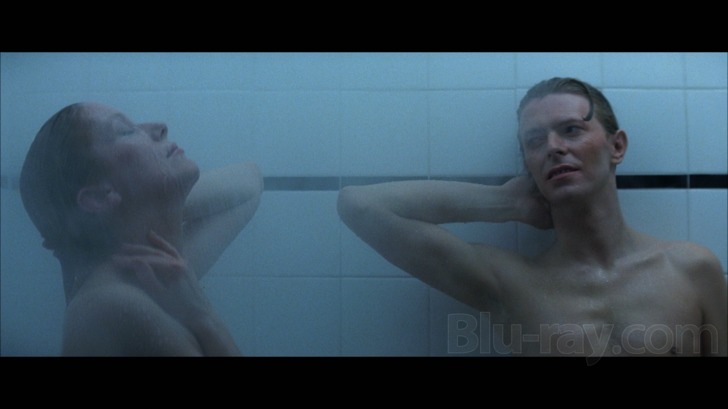
Miriam and John Blaylock (Catherine Deneuve and David Bowie) are a reclusive couple who live in a huge Manhattan townhouse, exquisitely decorated but cold, like a museum. They see almost no one, an exception being teenaged Alice Cavender (Beth Ehlers), a latch-key kid from a wealthy family who lives on the same city block. A violinist, Alice joins the Blaylocks three times a week for sessions of chamber music, with Miriam at the piano and John playing the cello. In flashbacks, we learn that Miriam met John when he caught her eye as a promising young performer at a royal court in the 18th Century, and she turned him into one of her kind. Miriam herself is much older. They hunt and feed as a couple. In the famous opening sequence, they select another couple (Ann Magnuson and John Stephen Hill) from the crowd at a disco where the musical group Bauhaus is performing. They take the unsuspecting pleasure-seekers to a secluded house on Long Island on the pretext of swapping partners, then kill and feed on them. "Forever", says John to Miriam afterward, as he gazes at her with loving eyes. But forever comes to an abrupt halt, when John suddenly begins to age rapidly, as if the years were catching up all at once. Miriam is resigned, having seen this before, but John attempts to fight his decline—and here is where The Hunger takes a uniquely modern turn. A scientist named Sarah Roberts (Susan Sarandon) has been much in the news because of her bestselling book promoting her studies on the biology of aging. Miriam has even attended one of Dr. Roberts' book signings. Desperate for help, John visits the Park West Clinic, where Dr. Roberts and a team that includes her boyfriend, Tom Haver (Cliff De Young), have succeeded in accelerating aging in lab animals but are stumped by the puzzle of how to reverse the process. The most important outcome of John's visit is to bring Miriam and Dr. Roberts together. It is clear, even before John's aging begins to accelerate, that Miriam has already chosen his successor. What better candidate than a scientist who can spend the next several hundred years perfecting her research on arresting the aging process? While The Hunger quickly became infamous as a "lesbian vampire" film because of Miriam's seduction of Sarah Roberts, everything we see of Miriam's relationships shows that they are based less on sex than on blood. In a scene that clearly influenced Kathryn Bigelow's Near Dark, Sarah's colleagues analyze her blood after her transformative encounter with Miriam and discover that two strains are fighting in her veins for dominance, and one of them is clearly winning. The fact that The Hunger appeared in 1983, just as the AIDS crisis was focusing both public and medical attention on blood-born pathogens, is not accidental. Nor is it surprising that the film's most nightmarish sequence isn't any of the Blaylocks' gory feedings, or even the Grand Guignol parade of corpses created for the changed ending on which the studio insisted. The scenes in the film that attracted the most attention at the time, even more than Miriam's "seduction" of Sarah Roberts, are those when John Blaylock is left sitting in the waiting area of the Park West Clinic, because Dr. Roberts thinks he's a crank who will simply get bored and leave. During a space of two hours, John ages by about forty years, and Dick Smith's remarkable makeup captures his physical disintegration with the kind of ghastly realism of which CGI can only dream. The 1980s were a decade in which a majority of America's baby boomers hit their fortieth birthday. Fitness clubs, jogging and healthy eating became all the rage, as a generation that worshipped youth suddenly discovered that it, too, was growing old. John Blaylock's predicament in The Hunger was precisely the nightmare that too many members of the film's contemporary audience were trying to repress. No wonder the studio didn't like Tony Scott's vision. The elegant painter of so many advertising fantasies had committed the ultimate sin: He'd painted a gorgeous canvas of youth, then etched a grinning skull in the middle with the words "Memento mori" beneath.
The Hunger Blu-ray Movie, Video Quality 
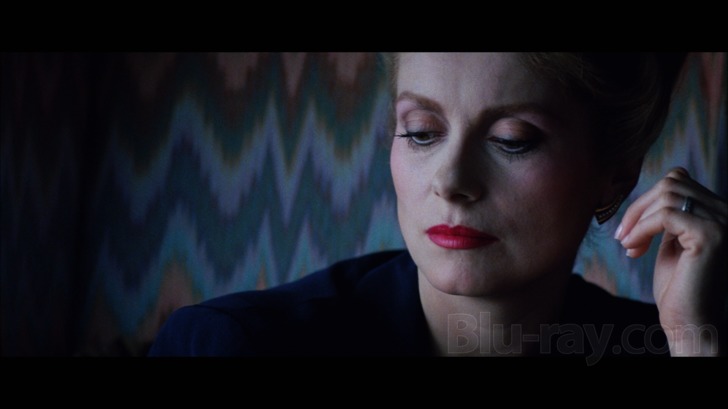
The Hunger was shot by British cinematographer Stephen Goldblatt, whose extensive credits range from the first two Lethal Weapon films to the recent Get On Up. The Warner Archive Collection has newly transferred the film at 2K from an interpositive for this 1080p, AVC-encoded Blu-ray. According to Scott's commentary, which was recorded for the 2004 DVD, the film's negative was digitally restored at that time by colorist Stefan Sonnenfeld, to address issues caused by fading. WAC's Blu-ray offers a beautiful reproduction of Scott's and Goldblatt's elaborate interplay of light and shadow, which serves as a constant reminder that cinematography has sometimes been called "painting with light". The Blu-ray's image is detailed, but fixating on the details would be tantamount to staring at the brushstrokes on a painter's canvas. The bulk of the shots in The Hunger fall into two categories, both of which are about mood and atmosphere: carefully composed long shots, often with areas that are deliberately underlit, especially in the Blaylock house or Dr. Roberts' lab; and extreme closeups, which intensify the focus on a particular object or texture but often leave the viewer unsure of the context, especially if the editor, Pamela Power (The Duellists), is jump-cutting between two different scenes, which is a common technique in The Hunger. Scott uses saturated colors for impact, especially red, sometimes gold and yellow, occasionally blue. The blacks that create mystery are deep and solid. The Blu-ray recreates these effects admirably. On the rare occasion when The Hunger ventures outdoors (e.g., a slow-motion walk by Dr. Roberts on the streets of Manhattan) the normalcy of the palette is a shock to the senses. Following the example of his brother, Ridley, in Alien, Scott used smoke in the air to give the film a textured look that the Blu-ray also captures. (Dr. Roberts is also a chain smoker.) The Hunger is a film where it is critical to get the densities just right, and WAC has done so. The Hunger has been mastered at WAC's usual target average bitrate of 35.00 Mbps, and the encoding has been capably performed.
The Hunger Blu-ray Movie, Audio Quality 
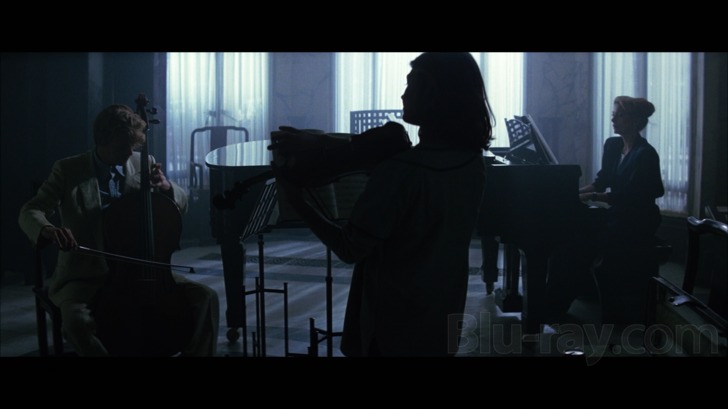
The Hunger was released in mono, formatted here in lossless DTS-HD MA 2.0 with identical left and right channels. The soundtrack is a demonstration of just how effective a mono track can be, with wide dynamic range, good fidelity and an approach to sound design that gets the most out of a single channel. In his commentary, Scott speaks of "shock cuts" in the film's editing; the soundtrack uses a similar technique in its sound edits, where one particular effect erupts into the mix and seizes the viewer's attention, immediately directing it elsewhere, even though the effect is coming from the same speaker. A good example occurs at the conclusion of the opening disco/hunting sequence, which is intercut with scenes from Dr. Roberts' research. Other examples use a more traditional approach by interrupting a scene with a jarring note from the underscoring credited to Denny Jaeger and Michael Rubini. In part because the Blaylocks are classical musicians, traditional compositions play a major role in the soundtrack. Miriam plays Sarah the duet from the opera Lakmé by Léo Delibes as part of her "seduction", which merges into an actual performance, with vocalists; the piece became even more famous a few years later when Scott used it again for what became a signature scene between Christopher Walken and Dennis Hopper in True Romance. The popular second movement of Schubert's Trio No. 2 in E-flat major for piano, violin, and cello can be heard several times in a special arrangement, including over the closing credits. Stanley Kubrick had already used it in Barry Lyndon, and Scott would use it again in Crimson Tide.
The Hunger Blu-ray Movie, Special Features and Extras 
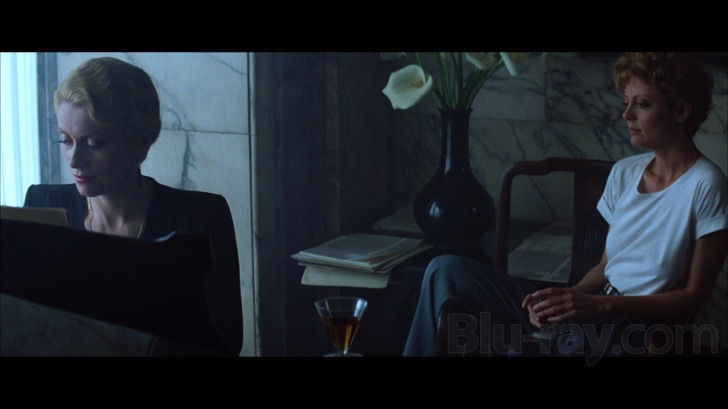
The extras have been ported over from Warner's 2004 DVD of The Hunger, with the exception of the photo galleries, which were extensive and included a poster collection.
- Commentary with Director Tony Scott and Actress Susan Sarandon: Scott and Sarandon were recorded separately and edited together, with Scott's comments occupying about 75% of the running time. Scott, who had just finished Man on Fire, is candid and direct about his style at the time and how he would approach the subject differently if he were making the film again. He also describes his influences, which include Nicholas Roeg's Performance and Roman Polanski's Repulsion, as well as the production, which occurred mostly in London to save costs. Sarandon recalls working with Bowie and Deneuve and describes with detached amusement how the film's frank sexuality changed both her career and her fan base (and also how one of her sons was shocked, many years later, when a friend at school informed him that his mother had starred in a notorious "lesbian vampire" movie).
- Theatrical Trailer (480i; 1.78:1, enhanced; 2:05).
The Hunger Blu-ray Movie, Overall Score and Recommendation 

The Hunger might enjoy a better reputation today if its ending made more sense. The ending that exists was intended to keep open the possibility for a sequel, but it appears to contradict the action that precedes it, and it leaves the viewer wondering what just happened. Sarandon says in her commentary that what intrigued her about the script was the choice presented to her character: whether to accept mortality or to live, potentially forever, at the price of being addicted to taking lives. Without giving anything away, let's just say that the studio's revised ending makes that choice irrelevant. Still, even in its current form, The Hunger remains a unique experience for anyone who believes that cinema is an art form based on sight and sound. Visions and harmonics as striking as these are rare indeed. Highly recommended.
Similar titles
Similar titles you might also like

Near Dark
1987

Female Vampire
La comtesse noire
1973

Dracula 3D
2012

Kiss of the Damned
2012

Def by Temptation
Temptation
1990

Doctor X
Warner Archive Collection
1932

Dracula
Collector's Edition with Theatrical & Badham color
1979

The Satanic Rites of Dracula
Count Dracula and His Vampire Bride
1973

Dan Curtis' Dracula
Bram Stoker's Dracula
1974

Daughters of Darkness
Les lèvres rouges | Remastered Special Edition | 4K Restoration
1971

The Invitation
Unrated & Theatrical Versions
2022

Jackals
2016

Vampire Ecstasy
The Devil's Playground
1973

Lust for a Vampire
1971

B'Twixt Now and Sunrise
The Authentic Cut
2011

The Nude Vampire 4K
La vampire nue | Limited Edition | Indicator Series
1970

Hellraiser
1987

Dr. Phibes Rises Again!
1972

Embrace of the Vampire
2013

Embrace of the Vampire
1995
